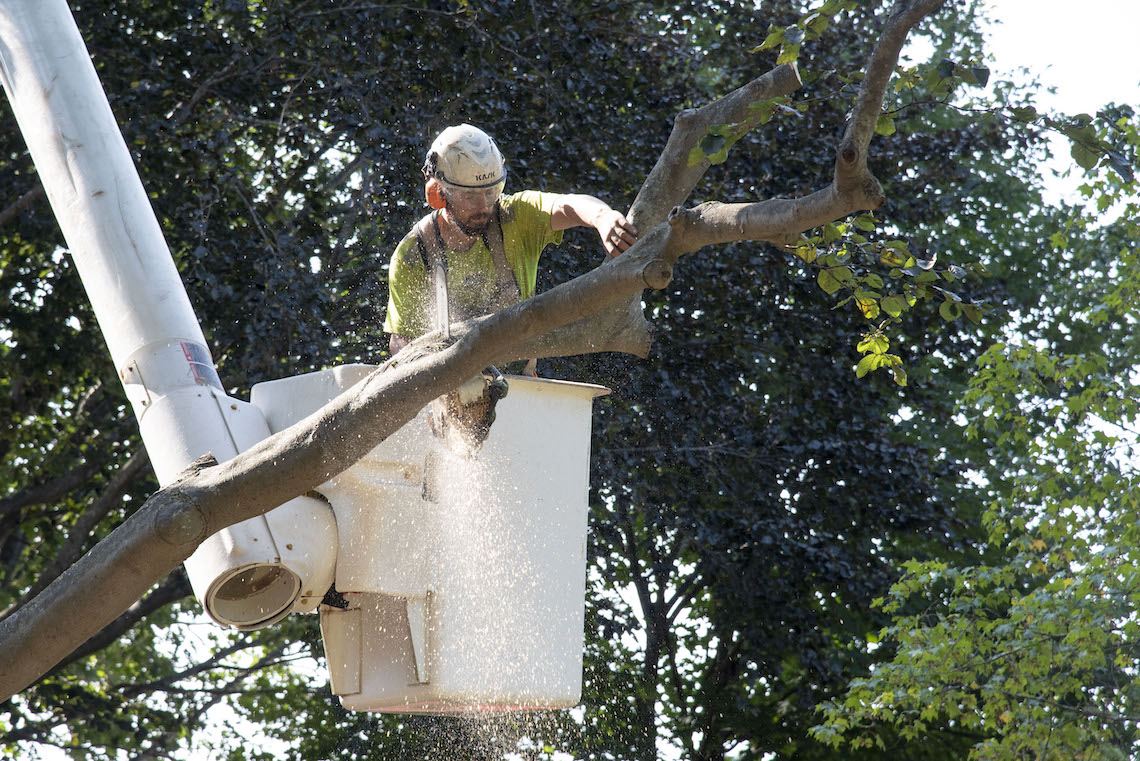
The distinctive, hollowed-out tree at the heart of the University of Southern Maine’s Portland campus was a living link to the past for every student who passed beneath its branches. It took centuries to grow, but only a few hours to cut down – a casualty of Hurricane Lee.
A team from Bartlett Tree Experts got to work early in the morning on September 22. They began at the outer edges, trimming away layers of branches on their way to the central trunk. The arm of the bucket truck shifted every few minutes to give its occupant the best angle to make cuts. As the branches fell, they were promptly gathered up and fed into a chipper.
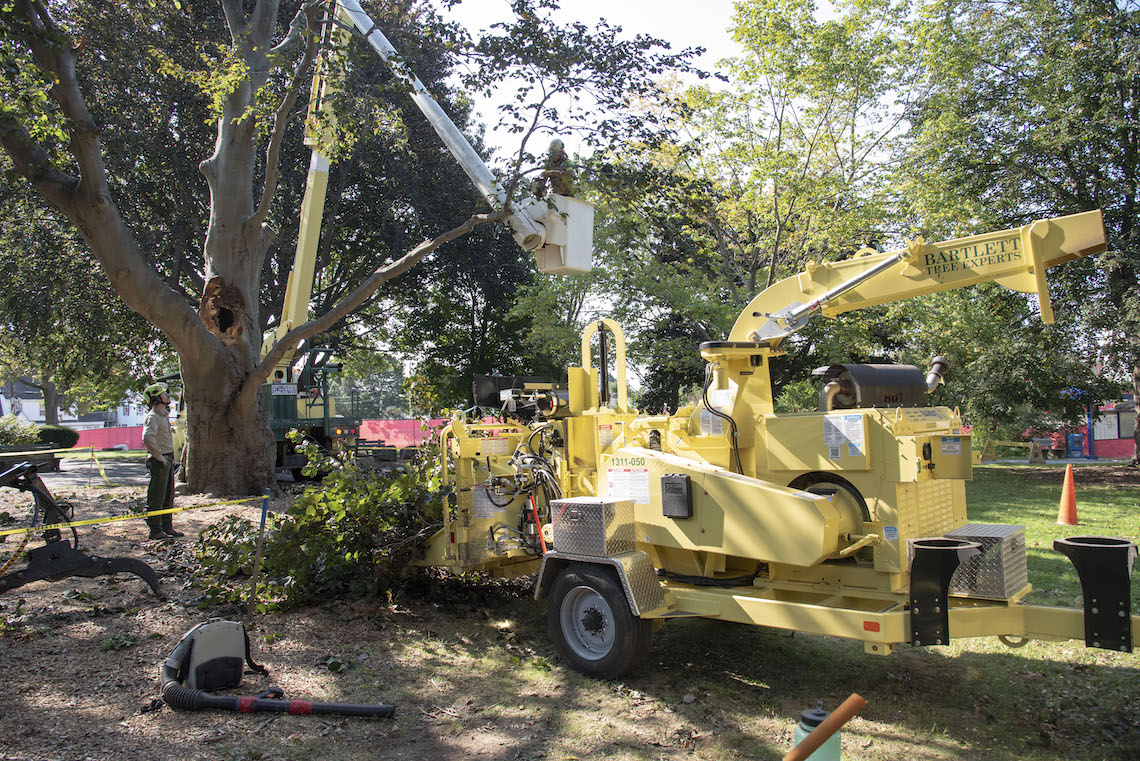
The buzz of chainsaw attracted a steady flow of onlookers from nearby Luther Bonney Hall where classes were in session. Curious faces filled the windows, while others wandered outside to snap a photograph or grab a souvenir twig. University groundskeepers stood watch along the perimeter to make sure everyone kept a safe distance.
By noon, the end was near. Everyone cleared the drop zone except Ian Fitzcharles. As crew leader for Bartlett, he handled the chainsaw for the difficult final stage. The five-foot diameter of the trunk required a piecemeal approach. Fitzcharles circled the base making angled cuts that would dictate where the tree would fall.
“Once you start watching the back of the gap open up on the back side of your cut and you know it’s going, and you’re like, ‘Alright, this is going right where we want it. Perfect.’ You step back and you just watch it,” Fitzcharles said. “Then you can feel it all right through the earth in your feet.”
A kicked-up cloud of dirt and sawdust was still thick in the air as the eager crowd came rushing in. One of the first people to reach the stump was Aaron Witham, the University’s Director of Sustainability. Good environmental stewardship is a top priority for him. He takes it personally to lose one of the trees under his care.
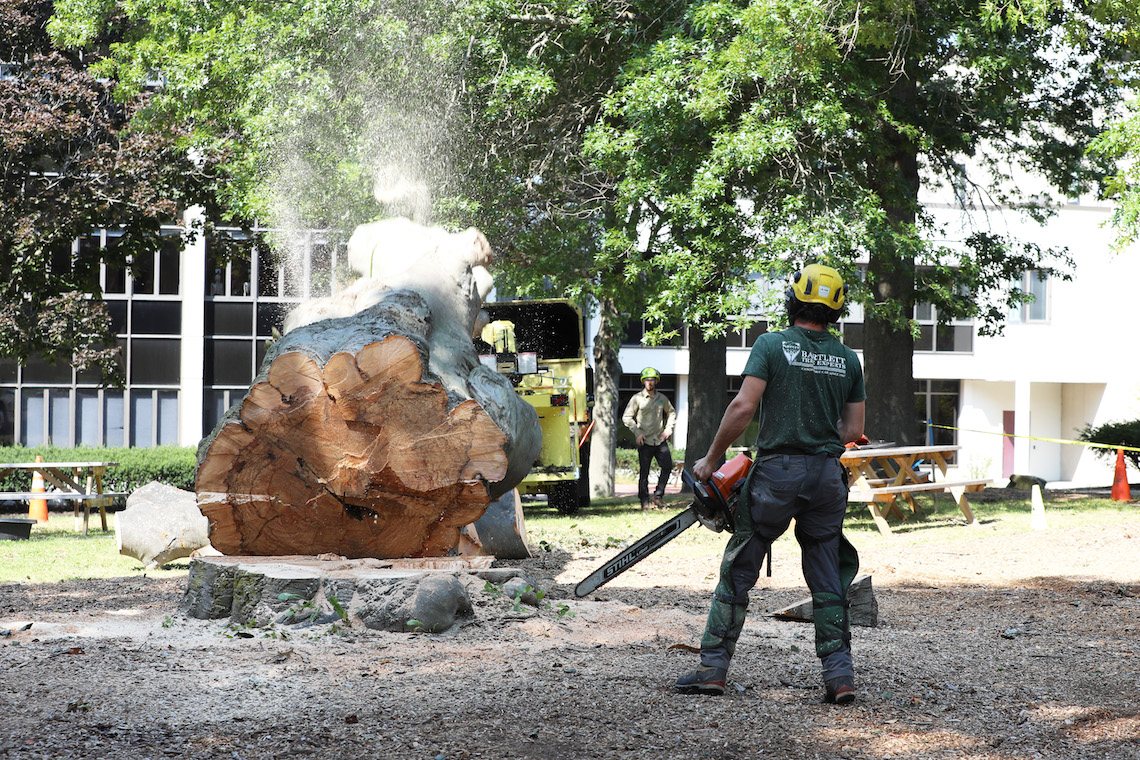
“To see it come down, it’s a heavy feeling for sure,” Witham said. “But I feel good about our community and the way we’re honoring it and all of the outpouring of support that I’ve received.”
Witham broke the news about the tree’s fate in a campus-wide email. He explained how Hurricane Lee dealt the fatal blow. The worst of the storm stayed out to sea, but it came close enough to Maine on September 16 to whip the coast with high winds. According to the National Weather Service, the wind in Portland gusted to 38 knots (43 mph).
One of the tree’s major limbs snapped under the strain, exposing more of the tree’s hollow center. In recent years, a nesting family of ducks and a barred owl were spotted peeking out from the hole in the trunk. Their home was now at risk of collapsing.
Witham contacted an arborist to assess the damage. The prognosis was negative. The remaining walls of the trunk were only a few inches thick in places, barely strong enough to support the full weight of branches. The arborist declared the tree a safety hazard and recommended its immediate removal.
The reaction was overwhelming. Witham received about 150 emails brimming with emotions and memories. The following quotes represent a sampling of those messages:
“Losing that tree is like the death of a loved one. It’s always hard to say goodbye. I’m glad to hear trees will be planted and will fill in somewhat. I am proud to call myself a TREE HUGGER!”
William Griffiths
Structural Specialist
Facilities Management
“Oh man, this makes me want to cry! That is the coolest tree ever.”
Catherine Johnson
General Manager
University Store
“My dad was the Bath city arborist for many years, so I was raised with a keen sense of love and respect for trees, and I appreciate working for an institution that honors them in such creative and thoughtful ways.”
Carrie Bell-Hoerth
Coordinator
Gorham Learning Commons
After seeing such strong feelings in print, Witham wanted to give people a chance to express themselves in person. He hosted a vigil on September 28. About 20 people gathered around the stump to listen as Witham recounted some of the history that made the tree so special.
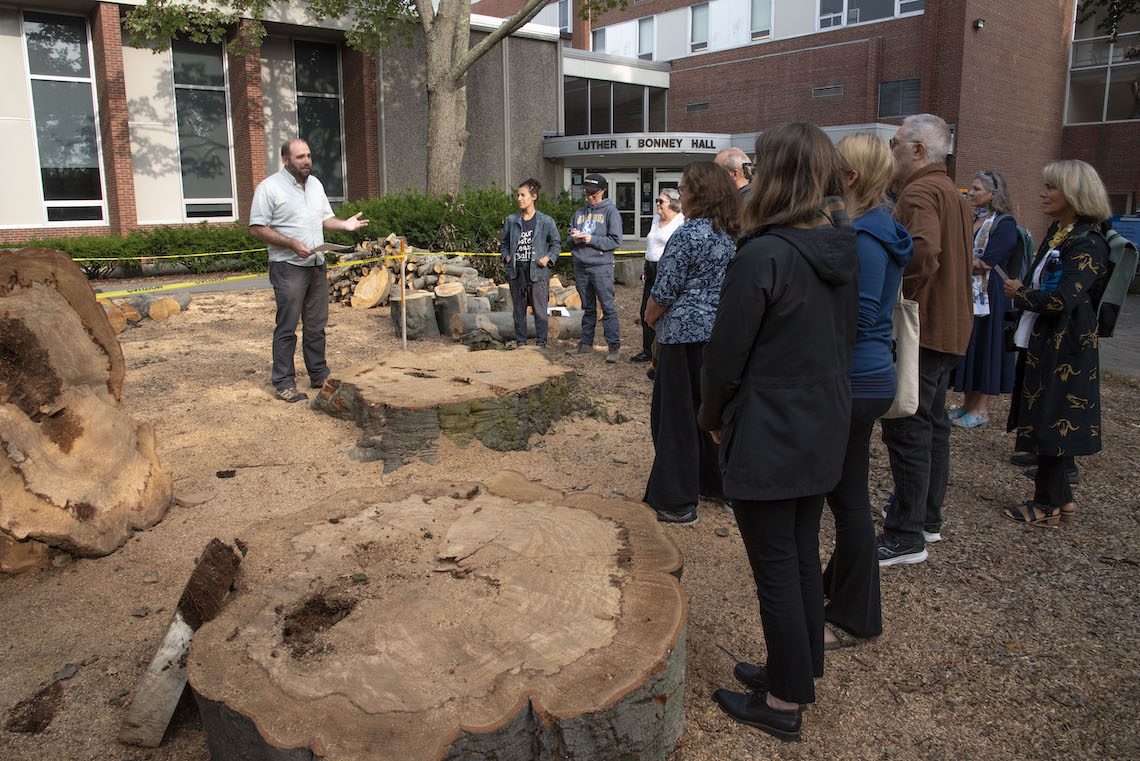
The tree’s scientific name is Fagus sylvatica, but it’s more commonly known as a copper beech or European beech. As the name indicates, it’s a non-native species imported from Europe. Its American cousins tend to be smaller because of their greater susceptibility to a disease that infects their bark.
Not only is the bark resilient, it’s also prized for its elephant-like appearance in terms of both its pearly gray color and wrinkled texture. The leaves of certain varieties can grow so dark they almost appear purple. Those aesthetic qualities probably appealed to the landowner who first planted the tree that became such a fixture of campus life.
Witham consulted with the University Historian, Dr. Libby Bischof, and they settled on 1804 as the approximate date of the tree’s planting. The land was then part of a 200-acre farm owned by James Deering. He was a contemporary of the celebrated poet Henry Wadsworth Longfellow, who was born in Portland in 1807.
The trees that grew in Deering’s farm made such an impression on Longfellow that he would rhapsodize about them in his poem “My Lost Youth.” Witham read a few lines at the vigil while standing in the same place where Longfellow presumably once stood:
My Lost Youth
“And Deering’s Woods are fresh and fair,
And with joy that is almost pain
My heart goes back to wander there,
And among the dreams of the days that were,
I find my lost youth again.”
Henry Wadsworth Longfellow
By 1878, the tree had already been growing for decades when the Western State Normal School was founded in Gorham. Portland Junior College bought the Deering estate for its campus in 1947. The Portland and Gorham institutions would merge in 1970 to form the University of Maine at Portland-Gorham, later renamed USM. The tree was there through every change.
Jo Sehon felt it was important to bear witness to the end of that historic run, first at the tree cutting and then at the vigil. Sehon is working toward a Pre-Med certificate. That commitment to health care also extends to the health of the environment.
“I see lots of people coming here, and I don’t see a lot of people coming when people are destroying entire little microcosms of an ecosystem around the Portland area and around Cumberland County,” Sehon said. “I think it would be good if we could respect those trees as much as we respect this one.”
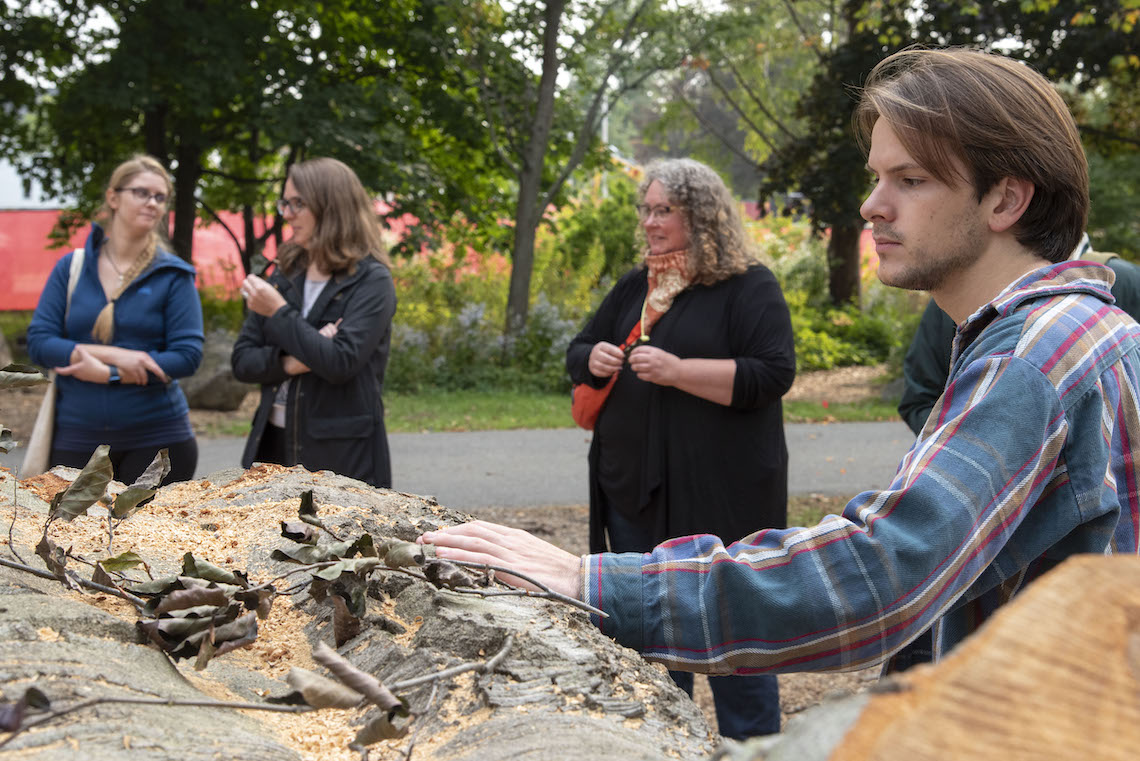
Once each visitor to the vigil had a chance to speak, Witham directed the crowd to a table with art supplies. They created mementos of the tree to take with them by pressing a leaf onto specially treated paper which reveals a colorful impression upon exposure to ultraviolet light.
A stack of wood blocks was set aside to be auctioned off. The money will go to the University’s arboretum fund to maintain the trees on campus. Witham hopes the buyers will give the tree new life by crafting the wood into furniture, bowls, game boards and more. The first round of bidding raised about $600 with another round on tap.
The University’s History and Environmental Science programs also claimed bits of wood to be used as educational tools. Even after the tree ceased to grow, its impact on campus will continue for years to come.
“There’s just so much love in our community for trees,” Witham said. “It’s days like this that, even though they’re sad, we get to see all that love come out.”

